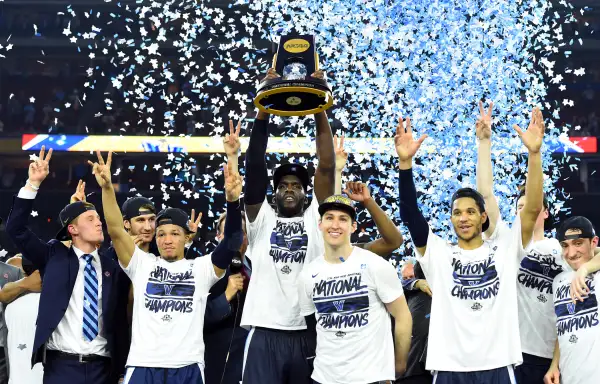What College Basketball Success Means for Schools Like Villanova

In all likelihood, it just got harder to get accepted as a student at Villanova University.
On Monday night, the school's men's basketball team won the NCAA championship over the University of North Carolina in dramatic, buzzer-beater fashion. And while the link between success in a university's sports programs and its student applications is well-chronicled across a broad range of colleges, the impact is felt especially strongly when small private schools like Villanova (ranked #75 on our Best Money Colleges list) achieve exposure and fan-favorite status on the national stage.
As one extensive 2009 analysis summed up, "private schools see increases in application rates after sports success that are two to four times higher than public schools." With more applications, colleges can be more selective with acceptances. Achievements in the sporting arena, then, tend to result in higher "quality" students and an overall better reputation for the college in the future, the study explained: "Schools appear to exploit these increases in applications by improving both the number and the quality of incoming students."
As the Philadelphia Inquirer reported, when Villanova last reached the NCAA tournament Final Four in 2009, the university received the equivalent of $6 million in free media publicity. Considering that the school didn't reach the final game, let alone win the championship that year, the 2016 basketball bonus felt by Villanova will be far greater—perhaps even as impactful as the school's 1985 NCAA championship over Georgetown, acclaimed as one the biggest upsets in all sports, bringing Villanova an unprecedented level of exposure.
Speaking of Georgetown University, it too has benefited as an institution by way of basketball success. Applications to Georgetown rose 45% between 1983 and 1986, around the time Patrick Ewing was leading the basketball team to three appearances (and one championship) in national title games. The so-called "Flutie Effect" is associated with another school in the Northeast, in light of Boston College applications surging 30% after the school's football team beat the University of Miami in 1984 thanks to Doug Flutie's last-second "Hail Mary" touchdown pass.
Read next: 12 Things Americans Are Suddenly Buying More Than Ever
More recently, surprisingly strong performances in the NCAA basketball tournament by the likes of George Mason, Wichita State, Butler, and Gonzaga universities have also been correlated with big increases in student applications—with rises of 81% at Wichita State and 41% at Butler following years they made the Final Four. The free media exposure granted to Butler and George Mason during their Cinderella runs in the tournament have been estimated at a staggering $450 million and $677 million, respectively.
Understandably, sales of team and university merchandise gear can soar as well when an unheralded program makes a splash in the tournament, like Florida Gulf Coast did in 2013 when it became the first #15 seed to reach the Sweet 16.
While some question the degree to which the Flutie Effect or Final Four Effect truly nudges applications skyward—in many cases, applications were rising for other reasons not related to sports—most agree there's some noticeable impact.
“Whether we can say it was directly caused by the run for the Final Four, there’s no statistical proof,” Dr. Robert Baker, director of the center for sport management at George Mason, told USA Today a couple of years ago. “But in reality, the correlation is so strong between those things happening and the vast amount of exposure, you can draw that assumption that they were related.”
The big takeaway is that all of this exposure heightens a school's profile—especially if it was a fairly low profile to begin with—resulting in more student applications, more selectivity in who gets accepted, and (perhaps) higher enrollment overall. While this scenario can make it more difficult for students hoping to get into these institutions, the boost to a school's reputation works out nicely for alumni (like me, 'Nova Class of '95), even if the team never got within a sniff of the Final Four when they were students.
So my old college buddies and I are hoping that a "Kris Jenkins Effect" is taking shape right now.

